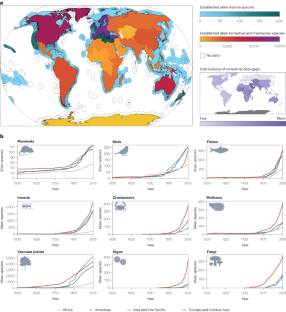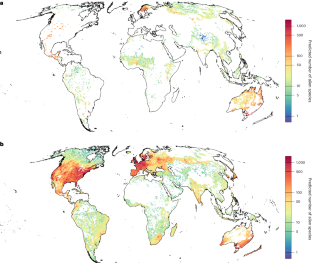2024-06-04 ロードアイランド大学(URI)
<関連情報>
- https://www.uri.edu/news/2024/06/uri-invasive-species-expert-co-leads-two-global-studies-published-in-two-nature-journals/
- https://www.nature.com/articles/s41559-024-02412-w
- https://www.nature.com/articles/s41893-024-01361-3
侵略的外来種による主要かつ増大する脅威の抑制は緊急かつ達成可能である Curbing the major and growing threats from invasive alien species is urgent and achievable
Helen E. Roy,Aníbal Pauchard,Peter J. Stoett,Tanara Renard Truong,Laura A. Meyerson,Sven Bacher,Bella S. Galil,Philip E. Hulme,Tohru Ikeda,Sankaran Kavileveettil,Melodie A. McGeoch,Martin A. Nuñez,Alejandro Ordonez,Sebataolo J. Rahlao,Evangelina Schwindt,Hanno Seebens,Andy W. Sheppard,Vigdis Vandvik,Alla Aleksanyan,Michael Ansong,Tom August,Ryan Blanchard,Ernesto Brugnoli,John K. Bukombe,… Sílvia R. Ziller
Nature Ecology & Evolution Published:03 June 2024
DOI:https://doi.org/10.1038/s41559-024-02412-w

Abstract
Although invasive alien species have long been recognized as a major threat to nature and people, until now there has been no comprehensive global review of the status, trends, drivers, impacts, management and governance challenges of biological invasions. The Intergovernmental Science-Policy Platform on Biodiversity and Ecosystem Services (IPBES) Thematic Assessment Report on Invasive Alien Species and Their Control (hereafter ‘IPBES invasive alien species assessment’) drew on more than 13,000 scientific publications and reports in 15 languages as well as Indigenous and local knowledge on all taxa, ecosystems and regions across the globe. Therefore, it provides unequivocal evidence of the major and growing threat of invasive alien species alongside ambitious but realistic approaches to manage biological invasions. The extent of the threat and impacts has been recognized by the 143 member states of IPBES who approved the summary for policymakers of this assessment. Here, the authors of the IPBES assessment outline the main findings of the IPBES invasive alien species assessment and highlight the urgency to act now.
先住民の土地への生物侵入 Biological invasions on Indigenous peoples’ lands
Hanno Seebens,Aidin Niamir,Franz Essl,Stephen T. Garnett,Joy A. Kumagai,Zsolt Molnár,Hanieh Saeedi & Laura A. Meyerson
Nature Sustainability Published:28 May 2024
DOI:https://doi.org/10.1038/s41893-024-01361-3

Abstract
Biological invasions are a growing challenge in a highly interconnected and globalized world, leading to the loss of native biodiversity. Indigenous peoples’ lands (IPLs) play a vital role in biodiversity conservation through activities such as land stewardship and management practices. Similar to protected areas, they are also often remote, with fewer connections to international trade networks. The extent to which IPLs are threatened by the spread of invasive species is still unknown. Here we provide a global study detailing the distribution and drivers of alien species on IPL. On average, IPLs host 30% (in absolute numbers: 11 ± 3.5) fewer alien species relative to other lands, after controlling for sampling intensities. Alien species numbers remained consistently lower on IPLs even after accounting for potentially confounding factors such as differences in accessibility and ecological integrity. The difference may result from land management practices of Indigenous peoples. In the relatively small number of cases where IPLs host disproportionately higher numbers of alien species than other lands, the most likely reason is high alien species propagule pressure arising from proximity to large urban areas. Overall, our results highlight the importance of IPLs in protecting nature in the face of increasing biological invasions.


